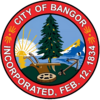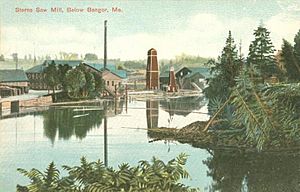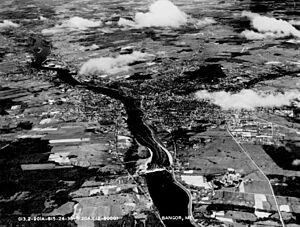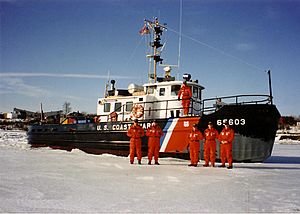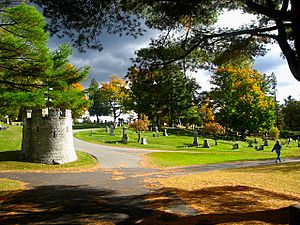Bangor, Maine facts for kids
Quick facts for kids
Bangor
|
|||||
|---|---|---|---|---|---|
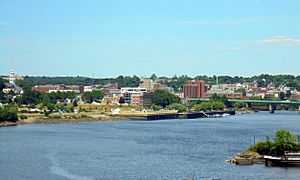
Skyline of Bangor in August 2017
|
|||||
|
|||||
| Nickname(s):
The Queen City of the East
|
|||||
| Country | United States | ||||
| Region | New England | ||||
| State | Maine | ||||
| County | Penobscot | ||||
| Settled | 1769 | ||||
| Incorporated (plantation) | 1791 | ||||
| Incorporated (town) | February 12, 1834 | ||||
| Incorporated (city) | March 26, 1853 | ||||
| Named for | Bangor, a Welsh hymn written by William Tans'ur | ||||
| Government | |||||
| • Type | Council–manager | ||||
| Area | |||||
| • City | 34.59 sq mi (89.60 km2) | ||||
| • Land | 34.26 sq mi (88.73 km2) | ||||
| • Water | 0.34 sq mi (0.87 km2) | ||||
| Elevation | 118 ft (36 m) | ||||
| Population
(2020)
|
|||||
| • City | 31,753 | ||||
| • Density | 926.85/sq mi (357.86/km2) | ||||
| • Urban | 61,210 (US: 441st) | ||||
| • Metro | 153,923 (US: 276th) | ||||
| Demonym(s) | Bangorean | ||||
| Time zone | UTC−5 (Eastern) | ||||
| • Summer (DST) | UTC−4 (Eastern) | ||||
| ZIP Codes |
04401–04402
|
||||
| Area code(s) | 207 | ||||
| FIPS code | 23-02795 | ||||
| GNIS feature ID | 0561558 | ||||
Bangor is a city in Maine, United States. It's the main city of Penobscot County. With about 31,753 people, it's the third-largest city in Maine. Bangor is often called the "Queen City."
In the mid-1800s, Bangor became important for its lumber and shipbuilding. Logs from the Maine North Woods floated down the Penobscot River to sawmills in the city. Then, the wood was shipped all over the world from Bangor's port. You can still see fancy old houses built by rich lumber owners. There's also a huge 31-foot statue of Paul Bunyan, a legendary lumberjack. Today, Bangor's economy focuses on services, retail, healthcare, and education.
Bangor has an airport, Bangor International Airport, which is also home to the Bangor Air National Guard Base. This airport used to be a key stop for planes flying between the U.S. East Coast and Europe.
What's in a Name?
Bangor was first settled in 1769 and became a town in 1791. It was originally called Kenduskeag Plantation. The name "Bangor" is thought to come from a Welsh hymn tune. It's also the name of Bangor, Gwynedd, a very old city in Wales. The last part of the name is pronounced "gor."
Bangor's Past: A Quick Look
Early European Settlement
The Penobscot people lived in the Bangor area for at least 11,000 years. They still live on the nearby Penobscot Indian Island Reservation. They hunted and gathered food. Europeans started visiting in the 1500s for the fur trade. The first European to explore the area was Estêvão Gomes in 1524. Later, Samuel de Champlain arrived in 1605. The area was fought over by France and Britain for many years.
In 1769, Jacob Buswell started a small settlement. By 1772, there were 12 families, a sawmill, a store, and a school. The population grew to 567 by 1787. It officially became Bangor in 1791.
Wars and Growth
During the American Revolutionary War, some American ships were sunk by the British fleet in Bangor in 1779. Six cannons from these ships were later found in the river.
In the War of 1812, British forces briefly took over Bangor in 1814.
Maine was part of Massachusetts until 1820. Then, it became the 23rd state in the U.S.
During the American Civil War, many soldiers from Bangor and nearby areas fought bravely. The 2nd Maine Volunteer Infantry Regiment was the first from Maine to march in 1861. The 1st Maine Heavy Artillery Regiment lost more soldiers than any other Union regiment. The 20th Maine Infantry Regiment famously defended Little Round Top at the Battle of Gettysburg. A bridge connecting Bangor to Brewer is named after Joshua Chamberlain, a hero from that regiment.
Bangor also played a role in the Aroostook War (1838–1839), a border dispute with Britain. This showed how important the lumber industry was becoming in Maine.
Lumber, Ships, and Factories
The area around Bangor was perfect for lumbering. In winter, logs were dragged by horses to the Penobscot River. When the snow melted, the logs floated down to sawmills near Bangor. The finished wood was then shipped from Bangor's docks to places all over the world. Many ships were also built in Bangor.
By 1860, Bangor was the world's biggest lumber port. About 150 sawmills worked along the river. The city shipped over 150 million board feet of lumber each year. Many of these shipments went to East Coast cities, the Caribbean, and even California during the California Gold Rush.
Rich lumber owners built grand Greek Revival and Victorian homes. Many of these beautiful houses still stand in the Broadway Historic District. Because of its beauty, Bangor was called "The Queen City of the East."
Besides lumber, Bangor was a top producer of moccasins in the 1800s. It also exported bricks, leather, and even ice.
In 1844, the first iron-hulled steamship in the U.S. was named The Bangor. It was meant to carry passengers between Bangor and Boston.
Modern Times in Bangor
Bangor continued to grow as the pulp and paper industry became important. Railroads also became more common than shipping.
Bangor's Hinkley & Egery Ironworks was a place for new inventions. In the 1920s, an engineer there invented the first car snow plow.
Bangor's Location and Landscape
Bangor is located at 44°48′N 68°48′W / 44.8°N 68.8°W. It covers about 34.59 square miles (89.60 square kilometers). Most of this area is land.
The city is located between Halifax, Canada, and other parts of Canada and New York. People hoped this location would make Bangor a major transportation link. However, most traffic between parts of Canada still goes north of Maine.
City Changes Over Time
Big Fires
Major fires hit downtown Bangor in 1856, 1869, and 1872. The Great Fire of 1911 was the worst. It destroyed many buildings, including the high school, post office, library, and hundreds of homes and businesses. The city rebuilt, and the area now shows many different building styles. It's listed on the National Register of Historic Places.
City Improvements
In the 1960s, some old downtown buildings were torn down to make way for new projects. This led to a decline in the city center. The Bangor Mall opened in 1978, drawing shoppers away from downtown. However, downtown Bangor started to get better in the 1990s. New bookstores, restaurants, galleries, and museums opened. The city's waterfront has also been improved, bringing more life back to the historic center.
The Penobscot River
Bangor is on the Penobscot River. The river is affected by ocean tides here. Flooding can happen when there's a lot of rain and melting snow. Ice jams can also cause floods. The United States Coast Guard started using icebreaker ships in the 1940s to prevent ice jams.
A big storm in 1976 caused a storm surge that flooded downtown Bangor for three hours. Water rose quickly, submerging many cars.
Bangor's Weather
Bangor has a climate with cold, snowy winters and warm summers. The average temperature in January is about 18.5°F (-7.5°C), and in July, it's about 69.5°F (20.8°C). It often drops below 0°F (-18°C) in winter. Summers can have days above 90°F (32°C). The highest temperature ever recorded was 104°F (40°C) in August 1935, and the lowest was -32°F (-36°C) in February 1948.
Bangor gets about 74.6 inches (189 cm) of snow each year. Snow usually falls from November to April.
| Climate data for Bangor International Airport, Maine (1991–2020 normals, extremes 1925–present) | |||||||||||||
|---|---|---|---|---|---|---|---|---|---|---|---|---|---|
| Month | Jan | Feb | Mar | Apr | May | Jun | Jul | Aug | Sep | Oct | Nov | Dec | Year |
| Record high °F (°C) | 63 (17) |
65 (18) |
84 (29) |
90 (32) |
96 (36) |
98 (37) |
99 (37) |
104 (40) |
99 (37) |
92 (33) |
75 (24) |
65 (18) |
104 (40) |
| Mean maximum °F (°C) | 48.9 (9.4) |
47.7 (8.7) |
57.9 (14.4) |
73.0 (22.8) |
84.6 (29.2) |
90.2 (32.3) |
91.5 (33.1) |
90.3 (32.4) |
86.0 (30.0) |
73.8 (23.2) |
63.5 (17.5) |
54.1 (12.3) |
93.9 (34.4) |
| Mean daily maximum °F (°C) | 28.1 (−2.2) |
31.2 (−0.4) |
40.1 (4.5) |
53.2 (11.8) |
65.7 (18.7) |
74.7 (23.7) |
80.4 (26.9) |
79.4 (26.3) |
71.0 (21.7) |
58.2 (14.6) |
45.8 (7.7) |
34.5 (1.4) |
55.2 (12.9) |
| Daily mean °F (°C) | 18.5 (−7.5) |
21.0 (−6.1) |
30.6 (−0.8) |
42.8 (6.0) |
54.5 (12.5) |
63.6 (17.6) |
69.5 (20.8) |
68.2 (20.1) |
59.9 (15.5) |
48.2 (9.0) |
37.3 (2.9) |
25.9 (−3.4) |
45.0 (7.2) |
| Mean daily minimum °F (°C) | 9.0 (−12.8) |
10.9 (−11.7) |
21.1 (−6.1) |
32.4 (0.2) |
43.3 (6.3) |
52.6 (11.4) |
58.6 (14.8) |
57.0 (13.9) |
48.8 (9.3) |
38.2 (3.4) |
28.8 (−1.8) |
17.3 (−8.2) |
34.8 (1.6) |
| Mean minimum °F (°C) | −14.1 (−25.6) |
−11.2 (−24.0) |
−2.1 (−18.9) |
20.3 (−6.5) |
30.8 (−0.7) |
40.7 (4.8) |
48.4 (9.1) |
45.2 (7.3) |
33.5 (0.8) |
24.3 (−4.3) |
12.6 (−10.8) |
−3.2 (−19.6) |
−16.9 (−27.2) |
| Record low °F (°C) | −29 (−34) |
−32 (−36) |
−16 (−27) |
4 (−16) |
23 (−5) |
29 (−2) |
37 (3) |
29 (−2) |
23 (−5) |
11 (−12) |
−3 (−19) |
−27 (−33) |
−32 (−36) |
| Average precipitation inches (mm) | 3.17 (81) |
2.38 (60) |
3.22 (82) |
3.61 (92) |
3.34 (85) |
3.87 (98) |
3.16 (80) |
3.06 (78) |
3.76 (96) |
4.58 (116) |
3.84 (98) |
3.72 (94) |
41.71 (1,059) |
| Average snowfall inches (cm) | 18.6 (47) |
17.5 (44) |
15.2 (39) |
3.7 (9.4) |
0.0 (0.0) |
0.0 (0.0) |
0.0 (0.0) |
0.0 (0.0) |
0.0 (0.0) |
0.6 (1.5) |
4.3 (11) |
14.7 (37) |
74.6 (189) |
| Average extreme snow depth inches (cm) | 14.5 (37) |
16.3 (41) |
14.2 (36) |
4.0 (10) |
0.0 (0.0) |
0.0 (0.0) |
0.0 (0.0) |
0.0 (0.0) |
0.0 (0.0) |
0.1 (0.25) |
2.3 (5.8) |
8.0 (20) |
18.7 (47) |
| Average precipitation days (≥ 0.01 in) | 11.2 | 9.9 | 11.3 | 11.6 | 12.4 | 12.2 | 10.9 | 9.8 | 9.4 | 11.4 | 11.3 | 12.6 | 134.0 |
| Average snowy days (≥ 0.1 in) | 8.0 | 7.6 | 5.4 | 1.7 | 0.0 | 0.0 | 0.0 | 0.0 | 0.0 | 0.2 | 2.0 | 6.4 | 31.3 |
| Average relative humidity (%) | 84 | 85 | 84 | 77 | 77 | 79 | 79 | 79 | 79 | 79 | 78 | 81 | 80 |
| Mean daily sunshine hours | 4.6 | 4.0 | 5.1 | 7.0 | 7.9 | 8.6 | 9.6 | 9.9 | 8.2 | 6.2 | 4.9 | 4.4 | 6.7 |
| Mean daily daylight hours | 9.3 | 10.5 | 12.0 | 13.5 | 14.9 | 15.5 | 15.2 | 14.0 | 12.5 | 10.9 | 9.6 | 8.9 | 12.2 |
| Average ultraviolet index | 2 | 2 | 2 | 3 | 4 | 5 | 5 | 5 | 4 | 2 | 2 | 2 | 3 |
| Source 1: NOAA | |||||||||||||
| Source 2: Weather Atlas (UV and humidity) | |||||||||||||
People of Bangor
| Historical population | |||
|---|---|---|---|
| Census | Pop. | %± | |
| 1800 | 277 | — | |
| 1810 | 850 | 206.9% | |
| 1820 | 1,221 | 43.6% | |
| 1830 | 2,867 | 134.8% | |
| 1840 | 8,627 | 200.9% | |
| 1850 | 14,432 | 67.3% | |
| 1860 | 16,407 | 13.7% | |
| 1870 | 18,289 | 11.5% | |
| 1880 | 16,856 | −7.8% | |
| 1890 | 19,103 | 13.3% | |
| 1900 | 21,850 | 14.4% | |
| 1910 | 24,803 | 13.5% | |
| 1920 | 25,978 | 4.7% | |
| 1930 | 28,749 | 10.7% | |
| 1940 | 29,822 | 3.7% | |
| 1950 | 31,558 | 5.8% | |
| 1960 | 38,912 | 23.3% | |
| 1970 | 33,168 | −14.8% | |
| 1980 | 31,643 | −4.6% | |
| 1990 | 33,181 | 4.9% | |
| 2000 | 31,473 | −5.1% | |
| 2010 | 33,039 | 5.0% | |
| 2020 | 31,753 | −3.9% | |
| 2022 (est.) | 31,588 | −4.4% | |
| sources: | |||
Bangor has been the third most populated city in Maine for over 100 years. In 2012, the Bangor area had about 153,746 people.
Historically, many immigrants came to Bangor as it grew. People from Ireland, Jewish communities, and Atlantic Canada settled here.
2020 Census Facts
In 2020, Bangor had 31,753 people living in 13,887 households. The city had about 926.9 people per square mile.
Most residents (88.0%) were White. Other groups included African American (2.3%), Native American (1.0%), and Asian (2.2%). About 2.4% of the population was Hispanic or Latino.
The average age in Bangor was 39.0 years old. About 18.0% of residents were under 18.
Bangor's Economy
Bangor is a major center for jobs in its region.
- Services and Retail: Big stores like Hannaford and Walmart are here.
- Finance: Bangor Savings Bank is Maine's largest independent bank.
- Healthcare: Hospitals like Northern Light Healthcare and St. Joseph's Healthcare are important employers.
- Education: The University of Maine, Husson University, and Eastern Maine Community College are key educational centers.
- Manufacturing: General Electric has a presence here.
Bangor is the biggest market, distribution, and transportation hub for a five-county area. This area has over 330,000 people.
Fun Things to Do
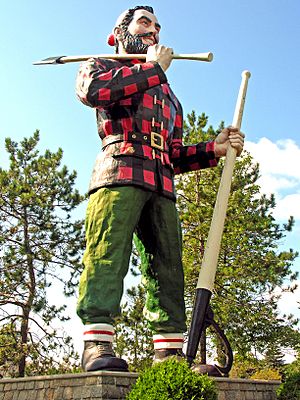
You can enjoy many outdoor activities in the Bangor City Forest and nearby areas. These include hiking, sailing, canoeing, fishing, skiing, and snowmobiling.
The Bangor Raceway at the Bass Park Civic Center hosts live harness racing in spring and fall. Hollywood Casino has slot machines, table games, a hotel, and parking.
Military Presence
Bangor Air National Guard Base is a military base. It started as a commercial airport in 1927. It is now home to the 101st Air Refueling Wing.
Arts and Culture in Bangor
Events to Enjoy
- The Bangor State fair is one of the oldest in the country. It happens every year in late July. It has farm exhibits, rides, and live shows.
Places to Visit
- The Cross Insurance Center is a large venue for events.
- The Maine Savings Amphitheater hosts outdoor concerts.
Cultural Spots
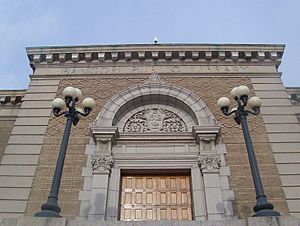
- The University of Maine Museum of Art and the Maine Discovery Museum are great places to explore. The Maine Discovery Museum is a big children's museum.
- You can listen to the Bangor Symphony Orchestra.
- The Penobscot Theatre Company puts on plays.
- The Collins Center for the Arts hosts various performances.
Cool Buildings and Art
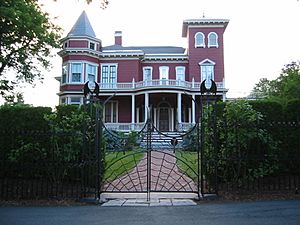
Many buildings in Bangor are listed on the National Register of Historic Places. The city has many beautiful Greek Revival, Victorian, and Colonial Revival style houses.
Some famous buildings include:
- The Thomas Hill Standpipe, a unique water tower.
- The Hammond Street Congregation Church.
- The St. John's Catholic Church.
- The Bangor House Hotel, which was one of the first "Palace Hotels" in the U.S.
- The Mount Hope Cemetery, a very old garden cemetery.
- The Bangor Public Library.
- The William Arnold House, an Italianate style mansion that belongs to author Stephen King. It has a special fence with bats and spider webs.
Public Art and Statues
- A part of the battleship USS Maine is on display in Davenport Park.
- There's a huge fiberglass statue of the mythical lumberjack Paul Bunyan.
- Sculptor Charles Eugene Tefft created three large bronze statues downtown. These include a memorial to Penobscot River Log-Drivers and a statue of Hannibal Hamlin.
- A sculpture called "Continuity of Community" is on the Bangor Waterfront.
- The U.S. Post Office has a mural called "Autumn Expansion."
- A bronze statue at the entrance to Mount Hope Cemetery honors the 2nd Maine Volunteer Infantry Regiment.
- A memorial honors Charlie Howard, whose story helped start EqualityMaine.
Sports and Recreation
From 2002 to 2017, Bangor hosted the Senior League World Series for Little League baseball.
Bangor also had two minor league baseball teams: the Bangor Blue Ox and the Bangor Lumberjacks.
The Penobscot is a salmon-fishing river. The Penobscot Salmon Club used to send the first fish caught to the U.S. President. Fishing for wild salmon is slowly getting better thanks to efforts like the Penobscot River Restoration Project.
The Kenduskeag Stream Canoe Race is a white-water event that starts north of Bangor. It has been held since 1965.
Learning in Bangor
Universities and Colleges
- The University of Maine in Orono is part of the University of Maine System.
- The Bangor campus of the University of Maine at Augusta.
- Husson University has about 3,500 students.
- Beal University offers degrees in nursing, healthcare, and business.
The Bangor School Department runs public schools, including Bangor High School.
Private schools include:
- The John Bapst Memorial High School.
- The Bangor Christian Schools.
- All Saints Catholic School.
Getting Around Bangor
Roads
Bangor is connected by major highways like I-95 and I-395. Three main bridges connect Bangor to Brewer.
Bus services like Concord Coach Lines and Cyr Bus Lines connect Bangor to other towns in Maine and to Boston. The Community Connector system provides local bus service within Bangor and nearby towns.
Railways
Freight train services are provided by Pan Am Railways and Central Maine and Quebec Railway. Passenger train service to Saint John, New Brunswick, ended in 1994.
Air Travel
Bangor International Airport is a public airport west of the city. It has a very long runway. It used to be a common stop for planes flying between the U.S. East Coast and Europe.
Healthcare
Hospitals
Bangor has two large hospitals: the Eastern Maine Medical Center and St. Joseph Hospital.
Health Challenges in History
In 1832, many Irish immigrants came to Bangor to escape a cholera outbreak in Canada. This led to the first large Irish-Catholic community in Maine. In 1849–50, Bangor itself faced a cholera outbreak. Later, a smallpox epidemic closed schools in 1872. The Spanish flu pandemic in 1918 affected over a thousand people in Bangor.
Sister Cities
Bangor has two sister cities:
 Harbin, China
Harbin, China Saint John, Canada
Saint John, Canada
Notable People
- List of people from Bangor, Maine
See also
 In Spanish: Bangor (Maine) para niños
In Spanish: Bangor (Maine) para niños



